Gallery FIT
March 6 – April 7, 2012
Exhibition website
Youthquake! The 1960s Fashion Revolution explored the dramatic impact of youth culture on fashion during the 1960s. Once only
the rich, the Establishment, set the fashion, said pioneering British designer and
boutique owner Mary Quant. Now it is the inexpensive little dress seen on the girls
in High Street.
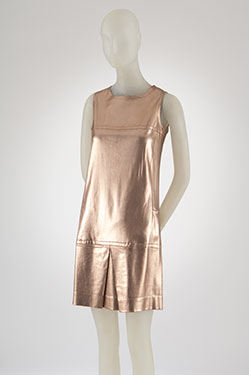
Paraphernalia, dress, copper lam knit, circa 1967, USA, gift of Mrs. Ulrich Franzen.
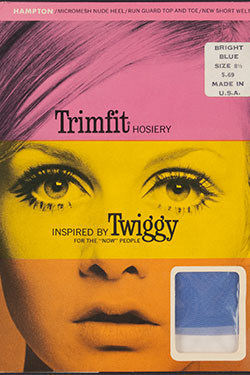
Trimfit, tights inspired by Twiggy in original packaging, nylon, paper, 1967-68, USA,
gift of Dorothy T. Globus.
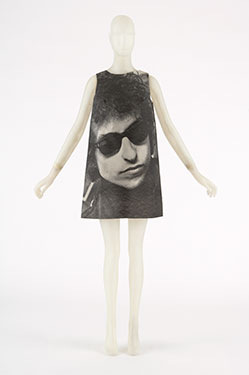
Dress with photograph of Bob Dylan by Harry Gordon, paper, black ink, 1968, England,
gift of Estelle Ellis.
Who created fashion, how it was made, and who could participate in it was redefined
by rebellious young people during this seminal decade. Youth subcultures challenged
the dominance of Paris couture as the fashion authority in the 1960s. The Mods and
the Hippies dressed to provoke in clothes that blurred and erased gender lines, exuded
sexuality, and embraced bold silhouettes and new materials. The exhibition was organized
according to three interrelated themes—boutiques, mass marketing, and high fashion—and features over thirty garments, accessories,
videos, and other related media.
The exhibition began by looking at a new generation of designers and their innovative
boutiques, where young clientele—an increasingly powerful consumer class—shopped and socialized. London was the epicenter of youth-generated style, but youthquake
boutiques soon began to open internationally. New York's Paraphernalia boutique sold
work by emerging talent such as Betsey Johnson, in addition to the work of London
designers. Paraphernalia's cutting-edge designs was represented by a mini-dress in
metallic copper knit.
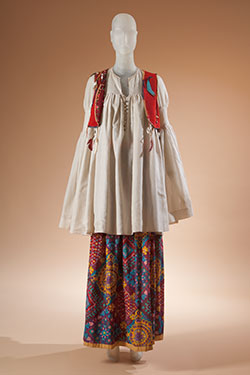
Giorgio di Sant'Angelo, ensemble, cotton, suede, shell, feathers, 1968, USA, gift
of Marina Schiano.
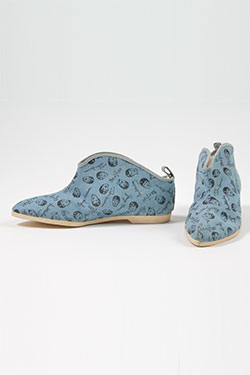
Wing Dings, boots printed with images of The Beatles, cotton canvas, rubber, 1964,
USA, museum purchase.
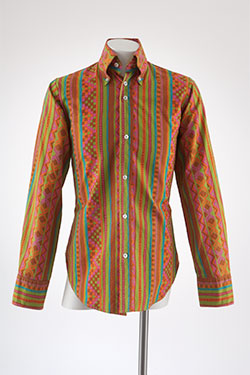
John Stephen, mans shirt, printed cotton, circa 1965, England, gift of Valerie Steele.
The exhibition went on to explore the infiltration of youthquake fashion into the
mass market. As seventeen-year-old Twiggy observed in 1967, The world is all for youth
now—because the young people have so much time and money to spend, all the businessmen
say lets cash in on youth. American mass market labels collaborated with London designers
to bring youthquake fashions and boutiques to department stores across the country.
The exhibition featured a powder blue vinyl mini-dress for Puritan Fashion Groups
Youthquake line.
Couture and high fashion ready-to-wear were also influenced by youthquake styles.
Forward-thinking couturiers embraced the spirit of youthful exuberance. They saw the
financial and creative potential in cultivating a younger market, and they began designing
mini-skirts and pantsuits, as well as opening their own ready-to-wear boutiques. The
exhibitions high fashion ready-to-wear included an example of an iconic Yves Saint
Laurent Safari tunic from his Rive Gauche boutique, famously worn by style-setters
Betty Catroux and Veruschka.
The end of the decade saw the rising influence of the Hippies, whose eclectic mix
of secondhand and ethnic dress was also translated into mass market and high fashion.
Natural materials such as leather, fur, shells, and feathers embellished Giorgio di
Sant'Angelo's rich hippie look, which was shown in a beaded hairpiece, suede vest,
and printed cotton skirt ensemble.
Youthquake! The 1960s Fashion Revolution was organized and curated by FIT graduate students of the Fashion and Textiles: History, Theory, Museum Practice program in conjunction with the Museum at FIT.


